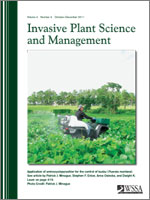As invasive species become increasingly abundant in forests, their presence may influence a number of key nutrient cycling processes. For example, Chinese privet has become well established in southeastern forests and continues to spread. Two studies, a multisite field investigation and a controlled approach on a single site, were conducted to examine the role of Chinese privet (Ligustrum sinense) on decomposition within riparian forests of the Georgia Piedmont. The field study also investigated the effects of privet presence on soil nitrogen (N) mineralization and microbial carbon and N immobilization. Both studies utilized a litterbag approach to examine how increasing proportions of privet in foliar litter influenced mass loss rates and nutrient dynamics. The field investigation included litterbags with representative proportions of the five dominant species from 16 sites. Litterbags in the controlled study were composed of specific levels of privet litter within bags (0, 10, 20, 30, 40, and 50% Chinese privet) as treatments. The litter quality of four native species was compared to Chinese privet in the controlled study. Both studies showed significant positive relationships between percentage of Chinese privet in litterbags and decomposition rates (2.6-fold rate increase with 30% privet in litterfall). Chinese privet leaf litter had lower lignin and cellulose concentrations, higher N concentrations, lower lignin ∶ N ratios, and narrower C ∶ N ratios than the native species. The positive relationship between mass loss rates and the proportion of Chinese privet in litter indicates that Chinese privet enhances decomposition rates as it becomes more abundant. During summer, N mineralization showed approximately a fivefold increase; during winter, microbial biomass N increased by approximately 30% on sites with the highest levels of privet in the understory. Consequently, C and N dynamics in Piedmont riparian forests were significantly influenced in direct proportion to the amount of privet present in the understory.
Nomenclature: Chinese privet, Ligustrum sinense Lour.
Interpretive Summary: This study examined the influence of a common invasive species, Chinese privet, on the biogeochemical functioning of deciduous riparian forests in the southeastern United States. Although Chinese privet is widely established as a component of floodplain forests, we know very little about how its presence might affect key drivers of forest productivity such as nutrient cycling. We found that C turnover rates in the forest floor increased by 260% on sites where litterfall was composed of 30% or more of Chinese privet. Similarly, during summer, N availability in surface soils increased fivefold on severely invaded sites. The implications of these changes for C storage and forest productivity are likely to be pronounced. Faster turnover times for C may stimulate a net decrease in soil storage since lower soil storage tends to be associated with faster decomposition. Given that virtually all forest sites in the southeastern United States are N deficient, increased N availability should stimulate net primary production. Because extensive control of Chinese privet is only feasible on a small-scale basis, it is important to understand how invasion may alter key societal values of these forests. Although forest productivity may increase, there may be a redistribution of growth toward forest components that have less economic value than many overstory species. In addition, wetland forests are stereotypically known as hotspots for C storage and sequestration and, consequently, that role may change in systems in which Chinese privet is a major component. The latter possibility is important in considerations of C mitigation strategies.





